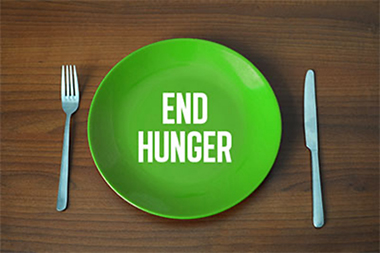What is Hunger?
“Hunger” is an evocative word. Everyone understands what it feels like to be hungry. Our stomachs start rumbling. We get irritable. It becomes hard to think straight. To make those symptoms go away, we eat something. Our stomachs are full, and we are content.
Over 44 million Americans face hunger each and every day including 1 in 5 children. If we think about hunger as most of us experience it, as a temporary sensation, the solution to this problem is straightforward: we just need to get more food to people who don’t have enough.
Food banks, shelters, and soup kitchens may seem like the answer to hunger in America. They are, however, a short-term and inadequate response. There has been a stunning increase in the number of emergency food programs over the last 40 years. In 1980, there were about 2 dozen food banks in the United States.
Today, there are more than 400, which serve 63,000 affiliated pantries and shelters. The growth of the emergency food system, however, has failed to solve “hunger.” Despite a spike during the Great Recession and during the pandemic, the prevalence of food insecurity has remained relatively constant over the past 28 years. In 2021, over 10% of households were food insecure, which is only slightly below the 11.9% rate that was recorded in 1995, the year the federal government started keeping statistics.
Defining the problem as “hunger,” as Janet Poppendieck contends, “has directed our attention away from the more fundamental problem.”
“Hunger” is best understood as a symptom of the larger issues of poverty and inequality. It needs to be addressed through a combination of economic and political solutions.
If we want to solve hunger once and for all, we need to reduce the need for emergency assistance that food banks provide.
Why are people hungry?
According to Feeding America, 72% of the households served by its affiliated food banks live at or below 100% of the federal poverty line and have a median annual household income of $9,175. In short, they don’t have enough money to consistently put food on the table. While unemployment is certainly a significant factor, 54% of the households Feeding America serves had at least 1 person employed in the past year.
of the households served by its affiliated food banks, have a median annual household income of
$9,175

In fact, most Americans are working harder than ever, but are still struggling to make ends meet. Income inequality has, by almost any measure, increased exponentially over the past 40+ years. Since 1980, most of the growth in wages has been concentrated among top earners, while wages for the average worker have stagnated.
More people than ever are enrolling in college to try and secure their future, but the ballooning cost of higher education means that most students will take on a sizeable amount of debt. The median student loan debt now stands at $37,575, more than doubling since 2007.
Meanwhile, the cost of housing and healthcare has continued to outpace incomes. The average person would need to make $25.82 per-hour to afford a modest 2-bedroom apartment – more than 3x the federal minimum wage. There are only 28 counties in the entire United States where a worker earning the minimum wage could afford to rent a one-bedroom home. The average worker also pays $450 per month for healthcare coverage, a number that jumps to $1,168 for family plans.

On top of that, the cost of the average meal increased from $2.94 to $3.25 in 2020. In some areas, however, the cost per meal is nearly twice the national average. For households that are often forced to choose between eating and paying the utility bills, every dollar counts.
If we want to solve hunger once and for all, we need to reduce the need for emergency assistance that food banks provide.
Who’s Hungry?
Although hunger affects every community in the United States, some groups of people are more vulnerable than others. African Americans are two times more likely to be food insecure than white, non-Hispanic households. Senior citizens are the fastest-growing food insecure population in the United States. One in 4 veterans of the Iraq and Afghanistan wars is food insecure. And a growing body of research shows that the number of college students facing hunger is skyrocketing.
The Impact
The negative costs extend far beyond individual households. A nation that allows more than 13% of its citizens to go hungry cannot achieve its full potential.
For starters, food insecurity among children has been linked to poor academic performance. Students who face hunger daily are more likely to score lower on standardized tests, repeat a grade, get sick more often, and be suspended from school. 46% of students from low-income households say hunger impacts their performance in school and 3 out of 4 teachers recognize students who regularly come to school hungry. The long-term consequences of sending kids to class hungry are substantial. Children who experience food insecurity in kindergarten fall behind and tend to stay behind.
46% of students from low-income households say hunger impacts their performance in school.
Food insecurity can also lead to a host of health problems. People who are hungry are 2.9x more likely to be in poor health and are more susceptible to chronic conditions like diabetes. Food insecurity has also been linked to higher rates of obesity among both adults and children. Low-income households are more likely to be uninsured and have to pay for the extraordinary costs of healthcare out of their own pockets, which drives them even deeper into poverty.
If millions of children can’t learn because they haven’t eaten breakfast, we are squandering the future of the next generation. If we consign illness onto an entire class of people, we are denying them their opportunity to succeed. Hunger is not simply an obstacle to be overcome, it’s a formidable barrier to a person’s, and, by extension, our country’s prosperity.
What Can We Do?
Move For Hunger’s mission is to mobilize the relocation industry to reduce food waste and fight hunger. Rescuing and donating meals for our neighbors in need is so important because, without emergency food providers, their situation would be even more dire. Food banks and soup kitchens, however, are not a long-term solution to the problem.
Moving? Set aside your unopened, non-perishable food items
Our crew will pack up your food and deliver it to the local food pantry
From there, your donations will be sorted and delivered to local families in need.
So while we must continue to donate our food when we move, hold food drives, and volunteer, we must also advocate for the policies that will address the root causes of hunger.
That means supporting higher minimum wages so that workers are being fairly compensated for their labor. It means increasing access to fresh and nutritious food. We must also strengthen safety net programs like SNAP and Medicaid, so that families who are experiencing hard times don’t fall deeper into poverty. Everyone should have access to an adequate place to live, so we need to protect and expand programs that will increase the supply of affordable housing. We should invest in our schools to ensure that all children are provided a quality education, fortify school breakfast and lunch programs so that kids are well-fed and able to focus during class, and supplement the disposable income of millions of families by providing child care assistance. Finally, we must acknowledge that hunger disproportionately affects African Americans, Latinos, and Native Americans and take steps to right the historical wrongs that have trapped a large percentage of these groups in poverty for generations.
Hunger exists because of choices we, as a country, have collectively made. Remedying the problem will require an extraordinary commitment to our disadvantaged citizens. Let’s keep delivering truckloads of non-perishables to our food banks and pantries, because millions of Americans need help today.
But we need to think bigger, ask the difficult questions, and confront the larger issues of poverty and inequality if we ever hope to end hunger once and for all.

